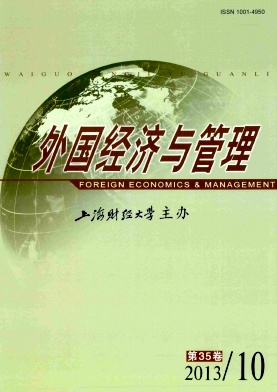管理创新研究现状评析与未来展望
外国经济与管理 2013 年 第 35 卷第 10 期, 页码:43 - 51
摘要
参考文献
摘要
管理创新是战略和创新研究的一个重要主题,并且被认为是企业长期竞争优势的一个重要来源,因而引起了管理学界和企业界的关注。本文在文献梳理的基础上,首先对管理创新概念进行了界定,并且指出了现有相关研究仍存在的疏漏之处;然后围绕管理创新影响因素以及管理创新与组织绩效关系两个主题对相关研究成果进行了评介;最后在分析现有管理创新研究仍存在的问题的基础上,对未来相关研究进行了展望,并构建了一个管理创新整合研究框架以供后续研究参考。
[1]Abrahamson E.Management fads and fashion:The diffusionand rejection of innovation[J].Academy of Management Re-view,1991,16(3):586-612.
[2]Abrahamson E.Management Fashions[J].Academy of Manage-ment Review,1996,21(1):254-285.
[3]Barney J.The resource-based model of the firm:Origins,im-plications and prospects[J].Journal of Management,1991,17(1):97-98.
[4]Birkinshaw J,et al.How management innovation happens[J].MIT Sloan Management Review,2006,33(4):81-88.
[5]Birkinshaw J,et al..Management innovation[J].Academy ofManagement Review,2008,33(4):825-845.
[6]Cosh A,et al..Organisation structure and innovation perfor-mance in different environments[J].Small Business Econo-mics,2012,39(2):301-317.
[7]Currie W L.Revisiting management innovation and changeprogrammes:Strategic vision or tunnel vision?[J].Interna-tional Journal of Management Science,1999,27(1):647-660.
[8]Damanpour F and Wischnevsky J D.Research on innovation inorganizations:Distinguishing innovation-generating from inno-vation-adopting organizations[J].Journal of Engineering andTechnology Management,2006,23(4):269-291.
[9]Drucker P F.Innovation and entrepreneurship:Practice andprinciples[M].New York:Harper and Row,1985.
[10]Eggers J and Kaplan S.Cognition and renewal:ComparingCEO and organizational effects on incumbent adaptation totechnical change[J].Organization Science,2009,20(2):461-477.
[11]Foss N.Selective intervention and internal hybrids:Interpre-ting and learning from rise and decline of the oction spaghettiorganization[J].Organization Science,2003,14(3):331-349.
[12]García-Morales A J,et al.Transformational leadership influ-ence on organizational performance through organizationallearning and innovation[J].Journal of Business Research,2012,65(7):1040-1050.
[13]Gebauer H.Explore the contribution of management innova-tion to the evolution of dynamic capability[J].IndustrialMarketing Management,2011,40(8):1238-1250.
[14]Greve H R.Performance,aspirations and risky organizationalchange[J].Administrative Science Quality,1998,43(1):58-86.
[15]Hamel G.The why,what,and how of management innova-tion[J].Harvard Business Review,2006,84(2):72-84.
[16]Harder M.Internal Antecedents of Management Innovation[D].Dissertation of the degree of Doctor at CopenhagenBusiness School:2011.
[17]Helfat C and Peteraf M A.Cognitive capabilities and the mi-crofoundations of dynamic managerial capabilities[R].Aca-demy of Management Conference,Montreal,Canada,August2010.
[18]Hernandez-Espallardo M,et al.Learning processes,their im-pact on innovation performance and the moderating role ofradicalness[J].European Journal of Innovation Manage-ment,2012,15(1):77-98.
[19]Hitt M A,et al.Direct and moderating effects of human ca-pital on strategy and performance in professional servicefirms:A resource-based perspective[J].Academy of Manage-ment Journal 2001,44(1):13-28.
[20]James H S L,et al.The adoption,diffusion and evolution oforganizational form:Insights from the agrifood sector[R].Working Paper,University of Missouri,2010.
[21]Knudsen T and Levinthal D A.Two faces of search:Alterna-tive generation and alternative evaluation[J].OrganizationScience,2007,18(1):39-54.
[22]Lin C Y and Chen M Y.Does innovation lead to perfor-mance?An empirical study of SMES in Taiwan[J].Manage-ment Research News,2007,30(2):115-132.
[23]McCabe D.“Waiting for Dead Men’s Shoes”:Towards a cul-tural understanding of management innovation[J].HumanRelations,2002,20(5):505-536.
[24]Mol M and Birkinshaw J.The sources of management inno-vation:When firms introduce new management practices[J].Journal of Business Research,2009,62(12):1269-1280.
[25]Nickerson J A and Zenger T R.A knowledge-based theory ofthe firm:The problem-solving perspective[J].OrganizationScience,2004,15(6):617-632.
[26]Porter M E.What is strategy?[J]Harvard Business Re-view,1996,74(6):61-78.
[27]Rosenbusch N,et al.Is innovation always beneficial?A meta-a-nalysis of the relationship between innovation and performance inSMEs[J].Journal of Business Venturing,2010,26(4):441-457.
[28]Staw B M and Epstein L D.What bandwagons bring:Effects ofpopular management techniques on corporate performance,repu-tation and CEO pay[J].Administrative Science Quality,2000,45(3):523-556.
[29]Tushman M L and Anderson P.Technological discontinuitiesand organizational environments[J].Administrative ScienceQuality,1986,31(3):439-465.
[30]Tushman M L and Rosenkopf L.Executive succession,stra-tegic reorientation and performance growth:A longitudinalstudy in the U S cement industry[J].Management Science,1996,42(7):939-953.
[31]Walker R M,et al.Management innovation and organizatio-nal performance:The mediating effect of performance man-agement[J].Journal of Public Administration Research andTheory,2010,21(2):367-386.
[32]Wallace W.The logic of science in sociology[M].Chicago:Aldine,1971.
[33]Vaccaro I,et al..Management innovation and leadership:Themoderating role of organization size[J].Journal of ManagementStudies,2012,49(1):28-51.
①有关Birkinshaw等《Management Innovation》一文的介绍可参见苏敬勤和林海芬(2010)的文章。本文重点介绍此后的研究进展。
②尽管采用管理创新概念展开研究的时间较晚,但广义的管理创新研究早已存在,并形成了一系列文献。其中,Chandler(1962)、Guillén(1994)、Zbaracki(1996)等的研究关注动因问题,Birkinshaw等(2008)的研究从理论上阐述了管理创新的产生机制,而Abrahamson(1991、1996和1999)、Carson等(2000)以及Benders等(2007)等的研究则关注管理创新的传播过程。
[2]Abrahamson E.Management Fashions[J].Academy of Manage-ment Review,1996,21(1):254-285.
[3]Barney J.The resource-based model of the firm:Origins,im-plications and prospects[J].Journal of Management,1991,17(1):97-98.
[4]Birkinshaw J,et al.How management innovation happens[J].MIT Sloan Management Review,2006,33(4):81-88.
[5]Birkinshaw J,et al..Management innovation[J].Academy ofManagement Review,2008,33(4):825-845.
[6]Cosh A,et al..Organisation structure and innovation perfor-mance in different environments[J].Small Business Econo-mics,2012,39(2):301-317.
[7]Currie W L.Revisiting management innovation and changeprogrammes:Strategic vision or tunnel vision?[J].Interna-tional Journal of Management Science,1999,27(1):647-660.
[8]Damanpour F and Wischnevsky J D.Research on innovation inorganizations:Distinguishing innovation-generating from inno-vation-adopting organizations[J].Journal of Engineering andTechnology Management,2006,23(4):269-291.
[9]Drucker P F.Innovation and entrepreneurship:Practice andprinciples[M].New York:Harper and Row,1985.
[10]Eggers J and Kaplan S.Cognition and renewal:ComparingCEO and organizational effects on incumbent adaptation totechnical change[J].Organization Science,2009,20(2):461-477.
[11]Foss N.Selective intervention and internal hybrids:Interpre-ting and learning from rise and decline of the oction spaghettiorganization[J].Organization Science,2003,14(3):331-349.
[12]García-Morales A J,et al.Transformational leadership influ-ence on organizational performance through organizationallearning and innovation[J].Journal of Business Research,2012,65(7):1040-1050.
[13]Gebauer H.Explore the contribution of management innova-tion to the evolution of dynamic capability[J].IndustrialMarketing Management,2011,40(8):1238-1250.
[14]Greve H R.Performance,aspirations and risky organizationalchange[J].Administrative Science Quality,1998,43(1):58-86.
[15]Hamel G.The why,what,and how of management innova-tion[J].Harvard Business Review,2006,84(2):72-84.
[16]Harder M.Internal Antecedents of Management Innovation[D].Dissertation of the degree of Doctor at CopenhagenBusiness School:2011.
[17]Helfat C and Peteraf M A.Cognitive capabilities and the mi-crofoundations of dynamic managerial capabilities[R].Aca-demy of Management Conference,Montreal,Canada,August2010.
[18]Hernandez-Espallardo M,et al.Learning processes,their im-pact on innovation performance and the moderating role ofradicalness[J].European Journal of Innovation Manage-ment,2012,15(1):77-98.
[19]Hitt M A,et al.Direct and moderating effects of human ca-pital on strategy and performance in professional servicefirms:A resource-based perspective[J].Academy of Manage-ment Journal 2001,44(1):13-28.
[20]James H S L,et al.The adoption,diffusion and evolution oforganizational form:Insights from the agrifood sector[R].Working Paper,University of Missouri,2010.
[21]Knudsen T and Levinthal D A.Two faces of search:Alterna-tive generation and alternative evaluation[J].OrganizationScience,2007,18(1):39-54.
[22]Lin C Y and Chen M Y.Does innovation lead to perfor-mance?An empirical study of SMES in Taiwan[J].Manage-ment Research News,2007,30(2):115-132.
[23]McCabe D.“Waiting for Dead Men’s Shoes”:Towards a cul-tural understanding of management innovation[J].HumanRelations,2002,20(5):505-536.
[24]Mol M and Birkinshaw J.The sources of management inno-vation:When firms introduce new management practices[J].Journal of Business Research,2009,62(12):1269-1280.
[25]Nickerson J A and Zenger T R.A knowledge-based theory ofthe firm:The problem-solving perspective[J].OrganizationScience,2004,15(6):617-632.
[26]Porter M E.What is strategy?[J]Harvard Business Re-view,1996,74(6):61-78.
[27]Rosenbusch N,et al.Is innovation always beneficial?A meta-a-nalysis of the relationship between innovation and performance inSMEs[J].Journal of Business Venturing,2010,26(4):441-457.
[28]Staw B M and Epstein L D.What bandwagons bring:Effects ofpopular management techniques on corporate performance,repu-tation and CEO pay[J].Administrative Science Quality,2000,45(3):523-556.
[29]Tushman M L and Anderson P.Technological discontinuitiesand organizational environments[J].Administrative ScienceQuality,1986,31(3):439-465.
[30]Tushman M L and Rosenkopf L.Executive succession,stra-tegic reorientation and performance growth:A longitudinalstudy in the U S cement industry[J].Management Science,1996,42(7):939-953.
[31]Walker R M,et al.Management innovation and organizatio-nal performance:The mediating effect of performance man-agement[J].Journal of Public Administration Research andTheory,2010,21(2):367-386.
[32]Wallace W.The logic of science in sociology[M].Chicago:Aldine,1971.
[33]Vaccaro I,et al..Management innovation and leadership:Themoderating role of organization size[J].Journal of ManagementStudies,2012,49(1):28-51.
①有关Birkinshaw等《Management Innovation》一文的介绍可参见苏敬勤和林海芬(2010)的文章。本文重点介绍此后的研究进展。
②尽管采用管理创新概念展开研究的时间较晚,但广义的管理创新研究早已存在,并形成了一系列文献。其中,Chandler(1962)、Guillén(1994)、Zbaracki(1996)等的研究关注动因问题,Birkinshaw等(2008)的研究从理论上阐述了管理创新的产生机制,而Abrahamson(1991、1996和1999)、Carson等(2000)以及Benders等(2007)等的研究则关注管理创新的传播过程。
引用本文
包玉泽, 谭力文, 王璐. 管理创新研究现状评析与未来展望[J]. 外国经济与管理, 2013, 35(10): 43–51.
导出参考文献,格式为:
上一篇:公司战略治理研究述评与展望
下一篇:互联网情境下的信任研究评介及展望





 9869
9869  318
318

